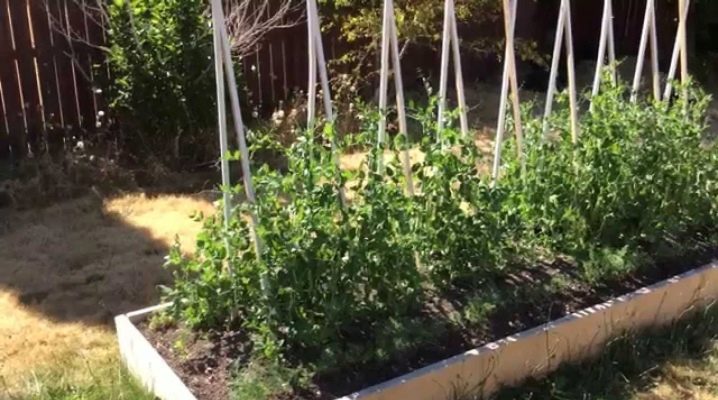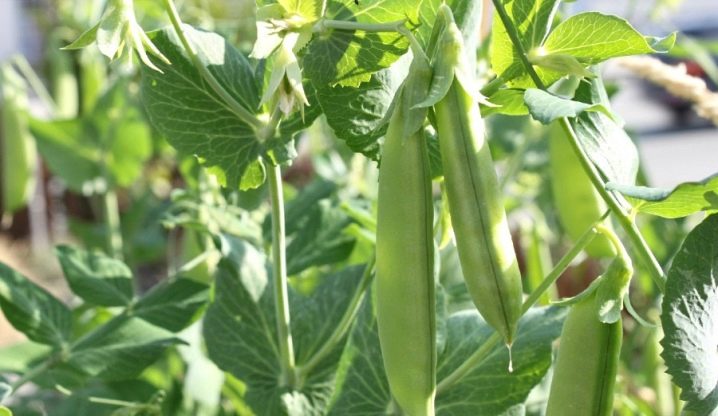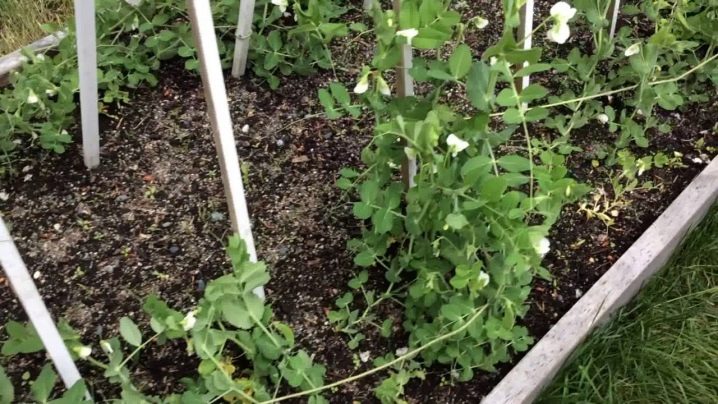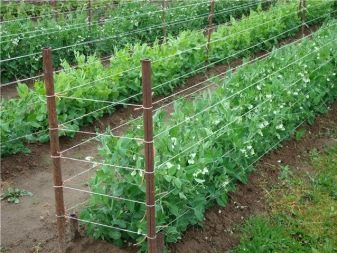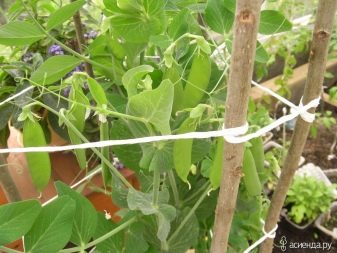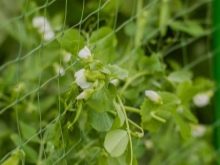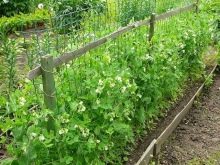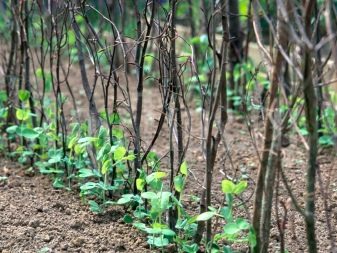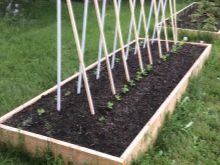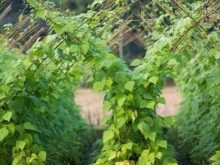How to make a support for peas?
Peas love to land many owners of suburban and personal plots. This culture is unpretentious to the growing conditions, cold-resistant and brings a tasty harvest of sweet peas in early summer. But for the crop to be really decent, the plants need support. Without it, wait for a good return on landing should not be.
What is the support for?
Reliance on peas is needed at a time when the height of its sprouts will reach 30 cm. An adult plant can rise to two or more meters. Without support, it will not be able to be upright due to the weakness of the stem. And therefore, already at a height of about 30 cm, peas are prone to lodging.
This should not be allowed for the following reasons:
- in a “creeping” position, individual plants are intertwined, which makes it difficult to subsequently harvest the pods;
- stalks, leaves and pods lying on the ground are subject to decay, drying out and other diseases;
- ripened pods can not always be found under the lying leaves and stems, they overripe, which gives the whole plant a “signal” about the end of the growing season; the result - the plant begins to dry;
- crop yields and precocity of planting are significantly affected: not all parts of the crop receive good lighting and are provided with fresh air.
In the presence of a support, the peas will be standing upright, well lit and looked around from all sides. The pods will ripen evenly, and the peas will have normal juiciness and sugar.
Domestic pea planting is usually not disturbed by dangerous diseases.
The timing of tying peas
When sprouts begin to appear the first antennae, the stems begin to strengthen to the support by tying up the string or their antennae. Becheva is needed for the initial period of crop growth, especially in those places where the wind often blows. When the wind gusts still weak and few antennae can not hold onto the supporting structure, and the loose fragile stems break. A little later, when the antennae will reliably hold the plant, it is better to remove the string so that it does not damage the stem. The first antennae grow at a height of sprout about 20 cm.As the peas grow, new tendrils appear, which also hook on the support.
On private plots and cottages, peas are more often grown in the open field, leaving places in greenhouses for vegetables, which must always be kept warm. And on the street there is a large selection of natural supports for him. For example, a fence from a chain-link or palisade, planting sunflower, a wall of a shed.
But if there is nothing of the above (or peas seeded in the greenhouse), then it will not be difficult to build supports from the improvised material with your own hands.
Types of fixtures
It is recommended to make supports for peas even before sowing seeds, in order not to disturb the sprouts and their roots.
We can distinguish the following types of devices to support this winding culture, most often found in gardeners:
- trellis supports;
- support stakes;
- constructions “hut” and “wigwam”;
- hard mesh
Demand always determines supply. Of course, you can buy ready-made supports, if available funds. For those who love to do everything to suit their desires and fantasies, the sale will find the necessary materials for the construction of a unique design under the peas.And still others will gather support from what is in the farm and the nearby forest, without spending a single ruble on it. But almost always, each owner gets something similar to one of the above-mentioned devices. This is due to the fact that these structures are basic, invented long ago, and there are not so many other options yet.
Ready made
Among the finished support structures for peas, it is worth highlighting several of the most popular.
- Grid U-45, basic for peas from not rotting material of 1х6 meters in size (brand "Protekt"). It is suitable for both stunted and tall varieties of plants grown in open and closed ground. Cell size - 45 mm. In the winter it needs to be cleaned, as it does not withstand low temperatures. For 6-meter beds with tall varieties of peas, you need to buy 2 such nets (one is 1 m high, and a foot is needed not less than two meters high).
- Mesh trellis F-170 from a strong thread with a thickness of 1 mm and a cell 150x170 mm. Roll size - 2x10 meters. In addition to peas, it is used for cucumbers, beans, beans and ornamental plants. The grid maintains low temperatures. It is required to pick up pegs-stands 2.5 meters long and drive them into the ground, where a pea garden is planned. Manufacturer - NP "Protekt."
- Rendell veneer sheet 2x5 meters in size with a 150 mm mesh. It will be convenient to complete with a folding stand made of wooden or welded frame (tapestry portable support).
In addition to the trellis, on sale you can find a rigid grid for pea support. More of these devices to detect anything in finished form is unlikely, but they are easy to make yourself.
Homemade
The presented devices are most often made by hand, therefore some of the novice gardeners may need a more detailed description of them.
- Trellis poles have different options, but the essence of all options is the same. At the ends of the pea beds two metal or wooden posts are driven into the soil. The elevated height of the clogged pillars must be at least two meters for tall peas and 1.5 meters for low peas. Cords or trellis netting are stretched between the pillars. The next trellis is stretched at intervals of 15–20 cm in height. The grid should be with cells no more than 10 cm.
- Stake for support firmly driven into a bed at a distance of 40-50 cm from each other along its entire length.They will serve as a support for growing plants. For stakes use iron rods, branches of fruit trees and shrubs, stakes made of wood, thin pipes up to two meters long.
- Construction "hut" is a support of long wooden poles, attached to each other in pairs in the form of a hut along the entire length of the bed. From above, the tops of all pairs are held together for durability with a “ridge”. Several longitudinal poles on the sloping sides of the “hut” also serve to strengthen the structure. Peas are sent along sloping poles to the “ridge,” clinging to both the poles and each other. The distance between the oblique pairs is about 1 meter, the length of the poles is 2 meters.
- The support, which is called the "wigwam" It has the shape of a peaked hut, similar to the dwellings of northern peoples and Indians. It is made of sloping poles, one end of which is stuck into the ground in a circle, and the other ends are tied to each other at the top of the resulting cone. A growing pea stem crawls on the outside of the structure, forming a pretty green slide. For such a support, the sowing of seeds must be appropriate - around the base of the wigwam.
- Rigid mesh support it is easy to install and therefore has a large number of different options: arches, vertical rows, vertical cylinders and sloping structures in the form of green arbors. For a rigid support get a galvanized grid with a cell of 12,2 mm and greenhouse arches. Plastic nets are also commercially available, but because of their short lifespan, they are not widely used among vegetable growers.
Tips
It is worth paying attention to a few tips from experienced gardeners when growing peas.
- To support peas you can use wooden fences. Their metal counterparts are not recommended to be used as a support for any climbing cultural plants: heating up in the sun, the metal can burn the stalks of the plants and lead to the death of the plants.
- Low-growing pea species need to be sown in two seeds per well. Two stems will grow that support each other, so they will not need special supports.
- The ideal mesh size for trellis nets is less than 10 mm. But if there are no such products on sale, you should not be upset - the peas will also delight on the support with a large mesh. Only it will be necessary to look after the correct attachment of the antennae of peas for support.
How to make a support for the peas with your own hands, see the next video.
